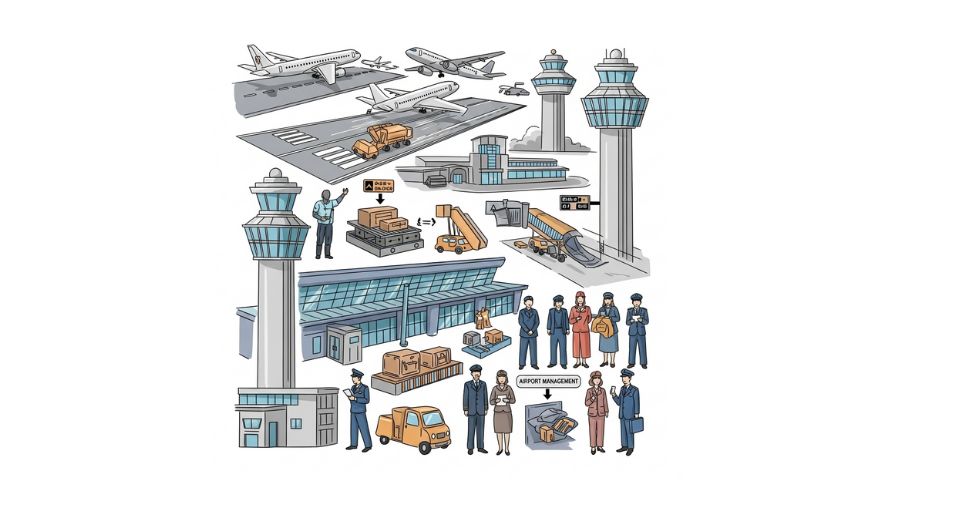MARKET OVERVIEW
The global low-cost airlines market, which is a part of the aviation and transport industry, will continue to redefine air travel consumption by individuals and companies. The sector is founded on lower-cost air carriers with prices attained through operating efficiencies, point-to-point flights, and reduced services compared to traditional full-service airlines. While its origins stay rooted on cost-effectiveness, the strategy of this market will increasingly stretch into more digital interaction, facilitated booking activities, and network flexibility to serve more reachability to poorer or price-sensitive segments. The carriers on the basis of this model will never rely on hub networks, which are prone to cause more connection durations and expenses.
Instead, the Global low-cost airlines industry will be built on direct flight services that reduce turnaround time and maximize aircraft utilization. It will be a template to facilitate high-frequency service between high-traffic city pairs that derive value from speed and convenience, not luxury or customization. Travelers will continue to turn to these airlines not just for low prices but for time-efficient options that align with changing travel expectations. The sector will also make carriers review cost models on a continual basis, supporting the employment of typical aircraft fleets, minimal on-board services, and unbundled pricing models. By making passengers pay separately for add-ons such as bags, food, or priority seating, global low-cost airlines market carriers will have pricing flexibility while maintaining a focus on lean operations. The model will not just lower overhead but also address different tastes among passengers without paying unnecessarily.
Airport selection will be at the core of the development of this market. Carriers in the Global low-cost airlines industry will expand to favor regional or secondary airports to reduce landing fees and reduce congestion-related delay. Those choices will create new travel routes and add air connectivity to previously underserved regions. As the aviation infrastructure matures, partnerships with airport companies will shape route development and frequency of service, furthering the competitive forces of this market.
Digital transformation will be strategically beneficial to companies dealing in this segment. Mobile-first platforms, automated customer support, and self-service features will streamline user experiences, ranging from ticketing to boarding. These technology pairings will allow for airlines in the global low-cost airlines market to reduce dependency on in-person staff while enhancing passenger autonomy. In-flight experiences will be lean by design, with emphasis on operational dependability and price transparency.
Regulatory regimes, particularly competition and consumer protection regimes, will shape the structure and marketing of services. Airlines will work through these constraints to remain compliant while continuing to enjoy the flexibility that defines their cost structure. Environmental regulations will, too, shape aircraft purchasing and route planning since Global low-cost airlines plays factor in fuel efficiency and emissions performance in long-term planning.
This market will continue to redefine the affordability of global air travel. It will evolve with tourism, migration, and remote work trends through scalable, efficient air transport options. As consumer expectations change, and as operational technology changes, the global low-cost airlines market will continue to hold its distinctive place within the broader aviation sector, characterized by a focus on access, simplicity, and focused cost management.
Gobal low-cost airlines market is estimated to reach $488,283.99 Million by 2032; growing at a CAGR of 5.7% from 2025 to 2032.

GROWTH FACTORS
The global low-cost airlines market is gradually revolutionizing the air transport industry. With more and more people seeking less expensive ways of traveling for pleasure as well as business, these low-cost airlines are gaining popularity in various parts of the world. The demand for lower prices is particularly strong in countries where disposable incomes are beginning to increase, and there is a growing middle class willing to travel to new destinations. These shifts in consumer patterns are helping low-cost airlines to become a common choice for millions who earlier considered air travel as a luxury.
This growth is also driven by tourism. With an increasing number of tourists planning weekend or holiday holidays, there is a demand for low-cost airlines. Business travel too is changing. Companies are now more cost-conscious and prefer low-fare short-haul travel to paying high fares, especially for brief meetings or conferences. This change of corporate mind works in favor of budget airlines expanding their customer base from just holidaymakers.
However, the path ahead is not without hindrances. The most significant among them is the unpredictable price of fuel. Since fuel forms a significant portion of the expense for airlines, any sudden increase can significantly impact their margins. These costs are generally difficult to pass on to customers without undermining their competitive edge. Also, limited services such as no free meals, less legroom, and less amenities make these airlines less desirable for travelers used to a better flying experience. This can make it harder for low-cost carriers to acquire high-end travelers aboard who anticipate more from their flight.
However, there are definite signs of promise. Growth to secondary cities and secondary airports could open up new routes and capture passengers with no existing access to frequent air transportation. These regions are likely to have lower competition and airport fees, which can help low-cost carriers lower their costs. Over the long run, this can equate to more comprehensive networks and brand loyalty, particularly from patrons who value convenience and cost.
Forward, the global low-cost airlines market will likely continue to evolve based on changing customer demands and general economic trends. With advancing technology and efficiency playing a more crucial role, the airlines that can deliver cost and experience equilibrium will be most sought after. By responding to demand and staying nimble, these airlines are set to grow incrementally but steadily and deliver real value in air travel in the future.
MARKET SEGMENTATION
By Purpose
The Global low-cost airlines industry will most probably experience gradual evolution as the travel needs of passengers shift and technology continues to influence how people prefer to travel by air. Over the next few years, the industry will most likely change to serve different types of travelers in more niche ways. As more people opt for affordable travel, it will be a top priority to eliminate extra costs without cutting services. The movement is not just about lower fares but also providing air travel to everyone. As low-cost carriers try to balance fare and comfort, the need for customized experiences will become even greater.
Looking at why people fly, some shared purposes emerge. One of the largest is leisure travel. People who are seeking to see new places without spending a lot of money generally use low-cost carriers. These travelers are usually willing to pay a price in order to break away and try something new, even if that means giving up some of the niceties in life. Since tourism is expected to grow, airlines will continue to focus on this market by offering convenient flights and user-friendly booking facilities that allow one to plan trips within budget.
Another strong reason for traveling is visiting friends and relatives. Such visits may not always be planned well ahead of time, and people are likely to take the cheapest mode of meeting their loved ones. low-cost airlines are a significant driver of this kind of travel, especially in bridging people across long distances. As communities become more spread out between nations, convenient and cheap flights will continue to be more crucial. In this sense, the global low-cost airlines market will continue to support strong social ties by making such visits possible.
Business travel is also part of this picture. Although most business travel is said to be conducted on full-service carriers, the trend has started to change. More and more companies are now ready to use low-cost carriers, especially for shorter distances or flights that do not entail much time spent in the air. As virtual meetings and remote work become the new reality, business travelers might not travel as much by air, but when they do, they will be seeking convenient and low-cost options.
All three of these functions recreational, visiting friends and family, and commercial will govern the trajectory of the Global low-cost airlines industry. The focus will be on meeting these needs without boosting prices, putting air travel within reach of all segments of passengers.
By Destination
The global low-cost airlines market will continue to grow as air travel becomes cheaper, and people seek affordable options to travel to different locations. These airlines have already made a notable presence felt as they offer lower fares compared to the traditional airlines. In the future, this industry will only grow bigger as more people prioritize budget-friendly travel over luxury. With technology, these airlines can discover new ways to decrease operating costs without compromising comfort and safety, and it will be that much easier for people to take to the skies that many times more often without shelling out too much money.
Domestic and international, the marketplace is divided by destination, and both will be subject to steady growth. Domestically, travelers will choose quick and inexpensive travel modes to make their way between cities. For the majority, money and time are important, and budget airlines can accommodate these needs by providing speedy flights that won't hurt the pocket. Where there are huge populations and growing middle classes, the demand will continue to rise, generating more flights and greater coverage at regional airports. Investment in infrastructure will also be included, with smaller airports being upgraded to handle more passengers, to accommodate low-cost airlines.
Globally, travelers will continue looking for low prices to travel to new countries. People are more and more adopting world travel, not just for leisure but also for learning and commerce. Thus, the global low-cost airlines market will have a better chance to span continents through more direct and affordable routes. Airlines can also launch new routes linking the favorite cities, which were earlier too costly or too distant to undertake a trip. This will not only open new paths for tourists but also for businessmen and students who have to travel across borders frequently.
The future of the market also rests in flying with newer and fuel-efficient planes. This will reduce expenses and preserve the environmental balance, too. With concern for sustainability rising across the world, even low-cost operators will have to adapt to some extent. There could also be an increase in digital technologies, i.e., mobile apps, to make travel reservations and automated check-in facilities, to improve customer satisfaction while saving costs. However, this will not happen immediately. The Global low-cost airlines sector is moving towards an inexpensive and interconnected future, where air travel is a common and convenient mode for the masses, both at the domestic and international levels.
|
Forecast Period |
2025-2032 |
|
Market Size in 2025 |
$332,452.72 million |
|
Market Size by 2032 |
$488,283.99 Million |
|
Growth Rate from 2025 to 2032 |
5.7% |
|
Base Year |
2024 |
|
Regions Covered |
North America, Europe, Asia-Pacific, South America, Middle East & Africa |
REGIONAL ANALYSIS
The global low-cost airlines industry is shaped by the unique nature and requirements of the different regions. As it continues to expand, both the market reflects current travel needs as well as prospective future prospects. In North America, for example, low-cost airlines already have a strong hold. The United States continues to show steady demand for low-cost travel, as low-cost airlines maintain competitive fares and frequent routes. Canada and Mexico are also seeing growing interest, especially as cross-border tourism and business travel grows. The vast distances and well-developed infrastructure of the area make low-cost flights a reasonable choice for most travelers.
Europe has been among the busiest areas for this market. Tourists there have already embraced low-cost flights, especially for short-haul travel between countries. Countries like the UK, Germany, France, and Italy have high traffic volumes for low-cost carriers due to their strong population density and robust tourism industries. The more standardized travel policy becomes between European nations, the more well-placed low-cost carriers are to capitalize on greater access and more efficient operations, and the easier and less expensive air travel will be for consumers.
Asia-Pacific has a lot of potential to be a new center for low-cost air travel. The growth in disposable income, especially in China and India, has made air travel accessible to the masses. The sophisticated aviation infrastructure of South Korea and Japan also adds to this trend. The diversity of this region, in addition to the increasing domestic and regional air travel, will further sustain the low-cost carrier establishment. With governments making investments in the transport sector and airports expanding, this market will keep receiving support as well as innovation.
In South America, the focus is on increasing connectivity as well as lowering the cost of travel. Brazil and Argentina are seeing growing entry of low-cost carriers into the market, providing alternatives to traditional airlines. The region still struggles with infrastructure and regulation issues, but as more people become aware of low-cost travel, the market will grow. Over time, more individuals will begin to utilize low-cost airlines as reliable means of leisure and business travel.
Middle East and Africa are starting to embrace early. In South Africa, Egypt, and the GCC nations, growing middle classes and urbanization are also enticing people towards low-cost travel. With airports getting modernized and regional alliances getting stronger, these areas can be major players in the coming times. Mostly, each area has a unique role to play, yet all are helping the size of the global low-cost airlines market grow.

COMPETITIVE PLAYERS
The global low-cost airlines market has made great strides year by year on the back of growing demand for cost cuts in travel. Individuals all over the world are looking for the cheapest way to travel their way to destinations they desire, as long as possible without cutting down on safety or comfort level. Thus, low-cost airlines have found themselves a force to be reckoned with in global aviation, attracting consumers of all stripes students and families, all the way up to business travelers looking to trim expenses. Where this industry segment is most interesting is the way in which competition has shaped its evolution, and how it will continue to advance in the future.
The global low-cost airlines market will face new challenges and opportunities in the future. With evolving customer needs, innovation in technology, and the growing importance of environmental concerns, low-fare airlines will need to rethink their business. But the market competition players are well acquainted with change. Ryanair and EasyJet, for example, have already shown how convenient it can be for such airlines to be flexible and responsive. They have consistently maintained low costs by offering fewer services on board, using secondary airports, and practicing efficient utilization of aircraft.
Southwest Airlines, JetBlue Airways, and Spirit Airlines in the US have also taken a cue, adapting their products to keep up with changing passenger needs. They have emphasized transparent pricing and route expansion, which helps them maintain a stable customer base. Meanwhile, airlines like Norwegian Air Shuttle and WestJet Airlines Ltd. are expanding their international presence by tapping both domestic and international travel demands.
Asian and Latin American airlines are also spreading their market footprint. AirAsia and Indigo, for instance, have developed a reputation for low fares with reliable service. Volaris, Gol Linhas Aéreas, and S7 Airlines are linking regional areas, mostly areas where options for transport have historically been lacking. These carriers are not following the trend but altering it by adopting new styles of acquiring and retaining customers.
In the coming years, competition to stay one step ahead will compel all of these players to look for new avenues, collaborations, and better-smart digital solutions. Automation, analysis, and enhancing customer service will play increasingly important roles. The destiny of the Global low-cost airlines sector will depend on these competitive players being able to grow and respond to an industry in constant pursuit of the next great leap forward.
Low-Cost Airlines Market Key Segments:
By Purpose
- Leisure Travel
- Visiting Friends & Relatives (VFR)
- Business Travel
By Destination
- Domestic
- International
Key Global Low-Cost Airlines Industry Players
- Ryanair
- EasyJet
- Southwest Airlines
- JetBlue Airways
- Norwegian Air Shuttle
- WestJet Airlines Ltd.
- AirAsia
- Spirit Airlines
- Frontier Airlines
- Indigo
- Volaris
- Allegiant Air
- Gol Linhas Aéreas
- S7 Airlines
- Peach Aviation
- Transavia
- Eurowings
- AirAsia X
WHAT REPORT PROVIDES
- Full in-depth analysis of the parent Industry
- Important changes in market and its dynamics
- Segmentation details of the market
- Former, on-going, and projected market analysis in terms of volume and value
- Assessment of niche industry developments
- Market share analysis
- Key strategies of major players
- Emerging segments and regional growth potential














 US: +1 3023308252
US: +1 3023308252






